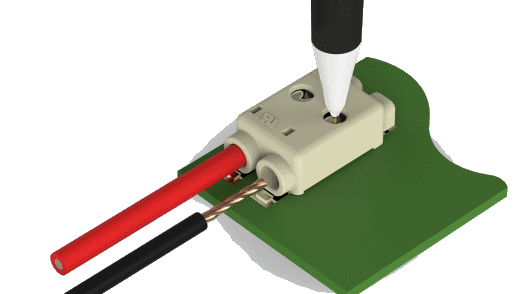Here are a few disparate but yet connected looks at optoelectronic trends, specifically for lighting fixtures, LED power, and displays by some cutting-edge companies.
TE Connectivity :
As lighting professionals are well aware, consumer demand for more LED lighting options has grown substantially. Consumers are more informed and recognize the environmental benefits of LEDs, as well as the increased lifespan that provides household savings. For lighting designers to stay on trend and develop products to meet the growing demand, they in turn have asked for products that will increase their productivity without increasing their costs.
One of the challenges for lighting design engineers developing new LED fixtures and applications is the need for specialized tools and soldering that can slow down the process. There has been a growing trend in the industry to develop solderless products that allow designers to skip the very time-consuming and often damaging process. Skipping the soldering phase also allows designers to go back to a design and reconfigure it in the future, for any reason, without damage to the LED light source.
Whether designing a new application or enhancing an existing design, lighting design engineers are charged to get reliable, efficient, cost-effective LED products on the shelves. The LED trend, combined with the race to the shelf, leaves designers looking for ways to save time and money. Connectors that can accommodate multiple design configurations that prevent wire damage, can assist tremendously in the design process.
Both commercial and consumer demands for LED lighting fixtures and applications is on the rise. Incandescent and fluorescent lighting will soon be phased out completely, leaving LED lights to dominate the industry. TE Connectivity , www.te.com
ON Semiconductor:
Recent research for the LED general lighting market indicated that mid-power LEDs represents >80 percent of devices shipped – roughly 48% of revenues, said Bernie Weir, Application and Marketing Manager for ac/dc power regulation. This is a change from a few years ago when revenue from high-power LEDs dominated the general LED market. Key factors that have driven this shift include improved LED efficacy, adoption of lower cost plastic packaging, and a move from magnetic transformers to mechanical approaches to achieve safety isolation. This is especially true in integral bulbs, and as a result the LED string voltage is no longer limited to 30 to 60 V depending on the regional safety requirements.
Often, mid-power LEDs are a combination of several low-power LEDs in series, in a single package. As a result, high voltage mid-power low current LEDs are available with typical forward voltages ranging from 9 to 100 V. One impact of using these LEDs is that alternate driver topologies, instead of the classical isolated flyback can be used that result in lower cost and/or higher power conversion efficiency.
These alternative topologies include buck, boost, and in some cases buck-boost, as well as simple approaches that use a bridge rectifier and a constant current regulator (CCR). One other consideration that arises from using high voltage strings of LEDs is that the mechanical design and materials selection can be impacted. This is because with non-isolated topologies, safety isolation has to be implemented by mechanical means instead of using a transformer. ON Semi , www.onsemi.com
Incom
Perhaps the most pervasive display trend of 2014 is also one of the most personal. It celebrates the technology now available for end-users to have the best of both worlds: tactile and touch experiences, on demand, said Michael Detarando, CEO for Incom.
Manufacturers and equipment makers have been calling for a high quality, cost effective way to innovate in both areas. The use of glass and polymer microstructure fused fiber optic components enables unparalleled interface possibilities. It empowers OEMs, with the seamless transfer of images within dynamic displays, as well as the latitude to transform conventional displays into any geometric shape/contour imaginable.
It gets even better for consumers: since their choices drive engineering and product development, the preference of tactile, touch or both may very well require the additional qualification of industry .
For example, combining fused fiber optics with interactive picture key technology is revolutionizing the global gaming industry, as players still like the tactile feel of a button that drives an action. (Whether it actually does or doesn’t is another story.)
For touch technology associated with tablets, smartphones and the many other endless displays of that type, fused fiber optic faceplates dramatically improve responsiveness, clarity and the overall experience by diffusing ambient light, while simultaneously illuminating the interface.
Bright ideas in fiber optics continue to fuel display innovation, production and end-user experience. Incom , www.incomusa.com
Company products
SMT releasable poke-in wire connector

TE Connectivity’s SMT Releasable Poke-In Wire Connector is at the forefront of the market with its low-profile and release mechanism that provides more robust and reliable lighting design options. The solderless connectors accommodate a wide range of connector configurations. The connectors also provide automated production with vacuum pick-up and high-temperature material for re-flow processing. TE Connectivity , www.te.com
Polymer/fused fiber optic-enabled displays

Vertical monitor showcasing innovative polymer/fused fiber optic-enabled displays and buttons, each with unique geometric, transmission and image characteristics. Incom , www.incomusa.com
Advertisement





